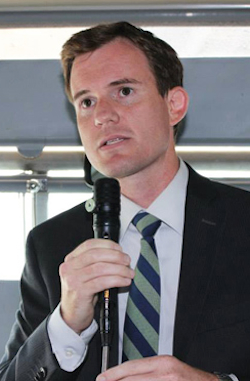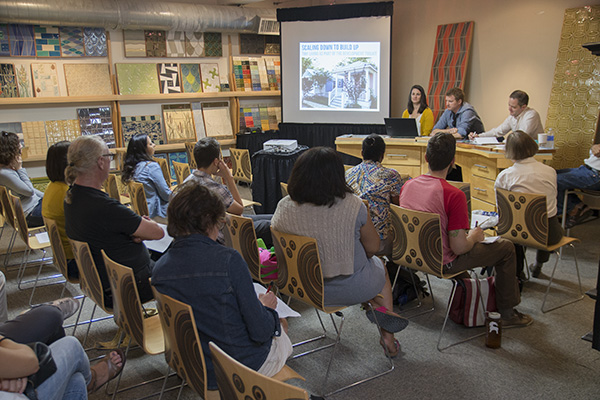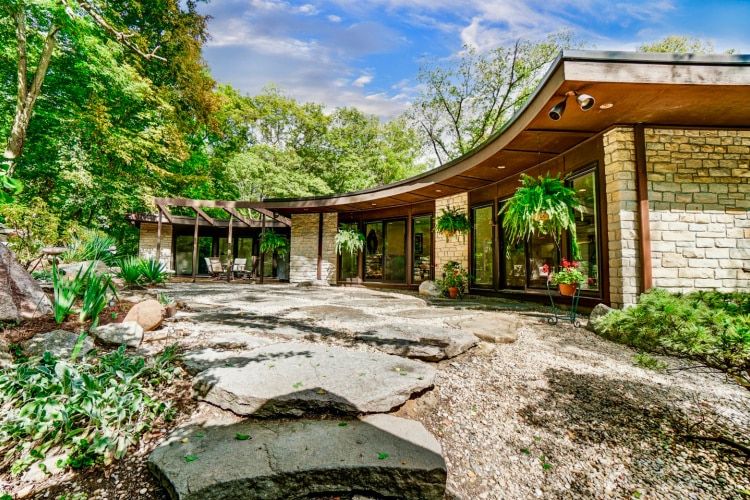How to activate your neighborhood in 5 steps this weekend
Kevin Wright and Joe Nickol believe in the power of pop-up biergartens in alleys and pop-up festivals in parking lots to transform neighborhoods, and they want to help you do it in your own neighborhood.
Did a pop-up biergarten in an alley where guests sat on empty paint buckets really kickstart the redevelopment wave in Walnut Hills? Did painting the asphalt and stringing lights across a parking lot really transform the Pike Street area of Covington into the city’s hottest real estate?
Given both neighborhoods’ long struggles to clean up blight, stabilize business districts and attract new residents, it’s crazy to focus on a party 50 people attended in Walnut Hills in 2013 and a parking lot some volunteers cleaned up in Covington in 2014. On the other hand, who’s to say that Five Points Alley wasn’t the tipping point for Walnut Hills and Madlot wasn’t the catalyst for a new vision of downtown Covington?
Kevin Wright and Joe Nickol believe in the power of a pop-up biergarten in an alley and pop-up festivals in a parking lot. They’re convinced that the imagination, energy and cooperation required to organize small-scale neighborhood events have led directly to millions of dollars in new investment in these two urban communities.
They’d love for you to prove them right by organizing events in underutilized areas of your own neighborhood. And they want to help you do it.

Wright is executive director of the Walnut Hills Redevelopment Foundation (WHRF), charged with coordinating efforts to attract investment, businesses and residents there. Nickol is senior associate at the Covington office of MKSK, a landscape architecture, urban design and planning firm.
After collaborating as friends and as professional colleagues on a variety of fun, attention-grabbing projects, they’ve decided to share their success stories and lessons learned via the web-based guide “5 Steps to Activating Your Neighborhood This Weekend.”
Their premise is deceptively simple, as explained on the guide’s landing page: “Looking for a way to activate your neighborhood? Instead of waiting for some outside entity to come in with the ‘big fix’ for your community, let’s begin to change our own story! What if we could get something new started over the course of just one weekend?”
The guide breaks down the process into five steps:
• Diagnosis: Take a walk with your neighbors and figure out what problem you should solve
• Space: Find a neglected space that could use attention and activity
• Partners: Could be your friends, a church, a restaurant, a hardware store
• Broadcast: Start small, use social media to get the word out, give the space a name
• Evaluate and repeat.
The big picture of why these activations are important for neighborhoods centers around basic supply and demand.
Wright acknowledges that the kind of large-scale redevelopment work needed in Walnut Hills is time-consuming, expensive and risky. Few developers are chomping at the bit to dump millions of dollars into new housing or businesses there, which is why the neighborhood has struggled for so long.
Since he can’t quickly move the needle on the supply of development funds, Wright and his WHRF staff — with help from Nickol and MKSK as well as funders like the U.S. Bank/Haile Foundation, LISC, P&G Foundation and Place Matters — have focused on driving demand. Their events and space activations are designed to prove to developers that existing residents care about their neighborhood and outsiders think Walnut Hills is a fun place to visit and might consider it a good place to live or open a business.

“The clearest way to determine the success of a place is to see if people use it,” Nickol says. “The best way to get people to come to a place is to offer the type of experience that draws them. It doesn’t take much, but it’s amazing how often it’s overlooked.”
“Since the first biergarten we’ve experienced approximately $15 million in public/private investment along the East McMillan Street corridor,” Wright says. “The success of the space has also led to a significant amount of funding that’s helping us develop Five Points Alley into a true park/pedestrian walkway.”
The sheer volume of event-planning effort is impressive, continuing with the annual Cincinnati Street Food Festival on Saturday, Sept. 26 along East McMillan. Madlot hosts the Art Off Pike festival again on Sunday, Sept. 27.
Last weekend saw an official groundbreaking for the Five Points renovation work. Murals are being painted by BLDG, landscaping designed by MKSK and construction headed by Lithko Restoration Technologies to turn the pop-up spot into a permanent public space.
Nickol and WHRF Development Officer Thea Munchel participated in last weekend’s Lots of Tiny (LOT) forum, speaking about the “tiny living” movement and how to scale down cities in order to build up true mixed-use neighborhoods.
Recent activation efforts in Walnut Hills have included turning a vacant lot into a community garden, inviting musicians to play on the street for Music Off McMillan and a partnership with Cincy Summer Streets. Just as importantly, those efforts have attracted other creatives to bring their own projects to Walnut Hills, from the Spaced Invaders “Fight the Blight” demonstration and Metro’s YP party bus to Hello Homes’ welcome packets and the annual Diner en Blanc event.
Wright now has a full-time staff of five at WHRF — besides himself and Munchel, there’s Sarah Marie Dotter, Betty Waite and the newcomer, Joe Sandmann. The organization’s website is being overhauled and will relaunch this weekend. A good way to follow their swirl of activity is through the social media hashtag #WeAreWalnutHills.
But Wright and Nickol don’t forget how they started small with a beer party in a forgotten alley. Now they’re hoping to inspire every neighborhood in Cincinnati and Northern Kentucky to start small themselves and build some sort of community momentum this weekend.
I asked Wright and Nickol to explain their “creative placemaking” concepts in greater detail.
What was the thinking behind your first Walnut Hills event in Five Points Alley?
Five Points is an intersection of five alleys that come together to create a unique space that had experienced years of overgrowth, blight, crime, dumping and general disinvestment. At a very minimum it needed to be cleaned up simply to help reduce crime and blight. From an urban planning perspective, it quickly became apparent that the reclamation of this space could be critical to the resurgence of the East McMillan Street corridor.
After some planning we spent a small amount of money and rented a large dumpster and some tools, created a Facebook event for a clean-up and had approximately 50 neighborhood volunteers help clean out the space. We easily filled the dumpster and lined the alleys with trash bags full of garbage. Instead of stopping there, we decided to throw a party for the volunteers and test the space as a possible pocket park/event space.
After some brainstorming we decided to have a “pop-up biergarten” the day after the clean-up. The idea was simple: Get some beer, a food truck, a musician and tell our friends. With no budget for tables and chairs we just bought paint buckets from the local hardware store, and they were embraced immediately due to their mobility and relative affordability. There were about 50 attendees, so we started doing them regularly and within a couple of months the event was easily drawing 200 people. The process was simple and small, and the outcome was hugely impactful.
The event put us on the map, so to speak, and began to help us garner interest in surrounding real estate opportunities. It truly helped investors, stakeholders, residents and visitors re-imagine and re-think the future of nearby Peeble’s Corner. Property owners have been involved and fully embraced the idea. They’re supportive of the positive changes, including allowing murals on their walls.
What are the short-term and the long-term goals of these kind of projects?
Engaging in short-term action for long-term change helps overcome the sometimes hard-to-find initial energy required for larger and more speculative projects. Short-term goals are typically more successful if they respond to a clear and immediate need with a potential impact that greatly exceeds the “little bet” risk presented by the project. So a well-designed clean-up day and afterparty or a temporary road-diet to turn unused travel lanes into space for people doesn’t pose a big financial risk but could potentially yield something extraordinary.
We design short-term projects with a hypothesis about the future of a street, public space or collection of buildings. If there’s a proof of concept, the ability to attract long-term public or private investment becomes much sounder.
Why should I (or any one individual) get involved in this sort of activation effort? Can one person make a difference? Isn’t that someone else’s job?
The “why” changes with each situation. In some cases it’s a resident who’s just tired of seeing discarded tires pile up, litter being tossed out of car windows or needles and other paraphernalia along a street. Or it’s a walking or cyclist group that just wants to make it easier to get around the neighborhood. Other times families want a place to meet up where the kids can run around while the adults enjoy a beer or two.
We’re also seeing increased interest from our community and real estate development partners to use this hypothesis-testing and demand-building as a way to build value, create authentic experiences and phase in development.
So whether you rock a blue suit or a blue mohawk, the door is open for you to innovate in the public domain. The public domain is probably the only true democratic place for interaction of all demographics. An inviting public realm reduces the perception of distance and makes people more willing to go outdoors.
Do I need permission from some government or organization?
This largely depends on context and location. In highly visible public spaces like streets, a permit likely will be required. This is particularly the case with street closures or when serving alcohol. Sometimes vacant lots are owned by the city or another entity that requires permission. In some instances it can be difficult to find who does own the land.
We would never recommend trespassing or breaking the law, but sometimes it’s easier to ask forgiveness rather than permission when you’re off the beaten path in some neighborhoods and getting started with something really small. Let common sense prevail and don’t be afraid to ask around to get the right permissions in place. The neighborhood association is often a good starting point.
Is there any help available if I need it?
These efforts are most successful with partners. In addition to neighbors and other people who may have a direct stake in the success of your venture, the city, neighborhood associations, police department and retailers are often willing partners. Organizations such as ArtWorks, People’s Liberty, Community ToolBank, Keep Cincinnati Beautiful, Keep Covington Beautiful, The Catalytic Fund and others have also become prominent in the mix.
We’re in the process of building an open-source toolkit to help inspire increased levels of neighborhood ownership based on our active experience in working with neighborhoods. In the meantime, you can check out our “look book” guide to get going.


















